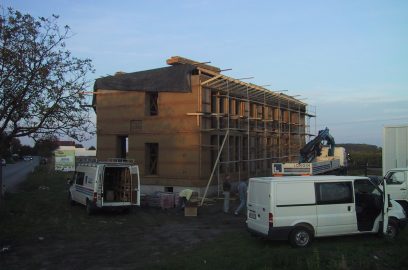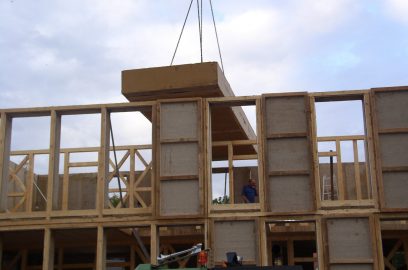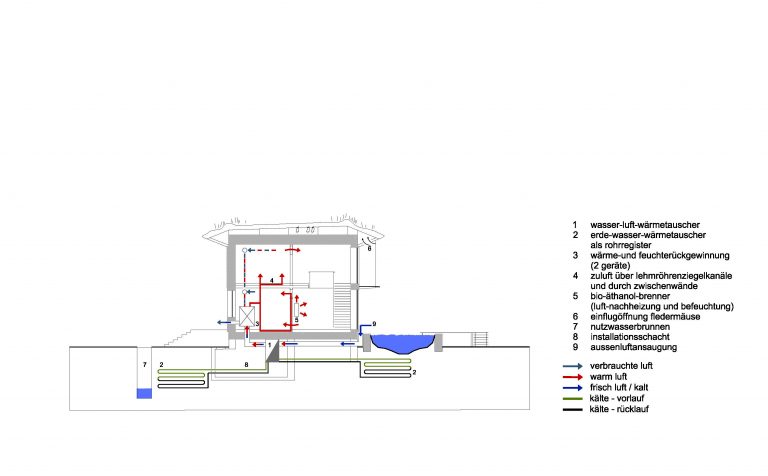The Building, situated along an outward road of the small village of Tattendorf, was placed at such an angle that it faces south and offers a generous view over the beautiful landscape (and the vineyards) from the paned opening hall. Although this diagonal placement means that the main façade does not face the street, it still remains visible from there. The building separates the northern workspaces (partially under a flying roof) from the southern visitor areas. It is accessible from the street on the narrow side through a vestibule (buffer room). The two-storey southern hall is an entrance area, communication zone and exhibition room that profits from direct sunlight. To the north (with diffused light only) are office, technics and service rooms on both floors. The building itself is a simple cube built on stilts with a slightly overhanging, rear-ventilated roof. The structure consists of newly developed prefabricated parts.
Construction Technique, Building Materials
A new, custom-built construction system was developed for this building. Its basic elements are a double (thermally separated) stilt construction, the most cost-saving insulating material straw, a new clay fleece technique (that replaces the usual vapour barrier and provides the area’s air density) as well as the high quality of newly developed organic fibre clay plastering that is suitable for exterior application.
These floor-to-ceiling n&l clay passive house® modules can be produced with a length of up to 9 m (pre-plastered on the inside and with a finished clay surface on the outside). During assemblage, these module stacks are bolted together conventionally, sealed and covered with a new, untreated clay fleece technique. The inside clay surfaces are free of all construction chemicals, stabilised bio technically with hemp fibre.
Both floor panels and ceilings are made from analogue prefabricated components. The additional roof construction is tiled with an extensive grass roof on the outside. The whole building is elevated on concrete strip foundations, doors, windows, floors and additional structures are made of wood.
The wall construction has been inspected for fire safety (F90).
Using straw in the Austrian climate means a very high risk of construction defects since humidity levels can easily be too high during the long construction time of conventional construction methods. This made us move the production of wall and ceiling parts to a production hall. Another reason was the fact that ecological construction and the standards of passive house construction demand a high-quality execution (which is easier to achieve in a weatherproof environment than on the construction site).
Passive House Standard
While the conventional passive house concept mainly concentrates on “passive operation” (with the high heat preservation putting aside additional technical and ecologically unsound measures), this new concept applies the idea to the building itself: the choice of construction materials and the according to construction method reduces the environmental impact to a minimum, practically passive and without additional technology. Wood, straw and clay can be produced CO2-neutrally (solar construction materials) and used without complicated additional technology, which means no environmental pollution. However, highly developed details and material usage are necessary for precise and environmentally friendly use, especially when it comes to the energy input for climatisation. These details were designed especially for this building system.
Using the chosen construction technique makes it possible to build almost salvage-free.
Energy Concept
The energy concept follows the “passive house”-strategy: heat insulation, as well as opaque and transparent components, conform to “passive house standards”. Supply air is preconditioned via a groundwater perfused register, an earth canal; an air heat exchanger with heat recovery reduces heat losses through aeration. Within the building, the airflow is partly routed through hollow clay blocks. Residual heat is provided by the façade hot water collectors as well as an additional bioethanol heater, that also supplies the compartment air with humidity. Photovoltaic cells on the southern façade cover at least the entire basic power supply.


























